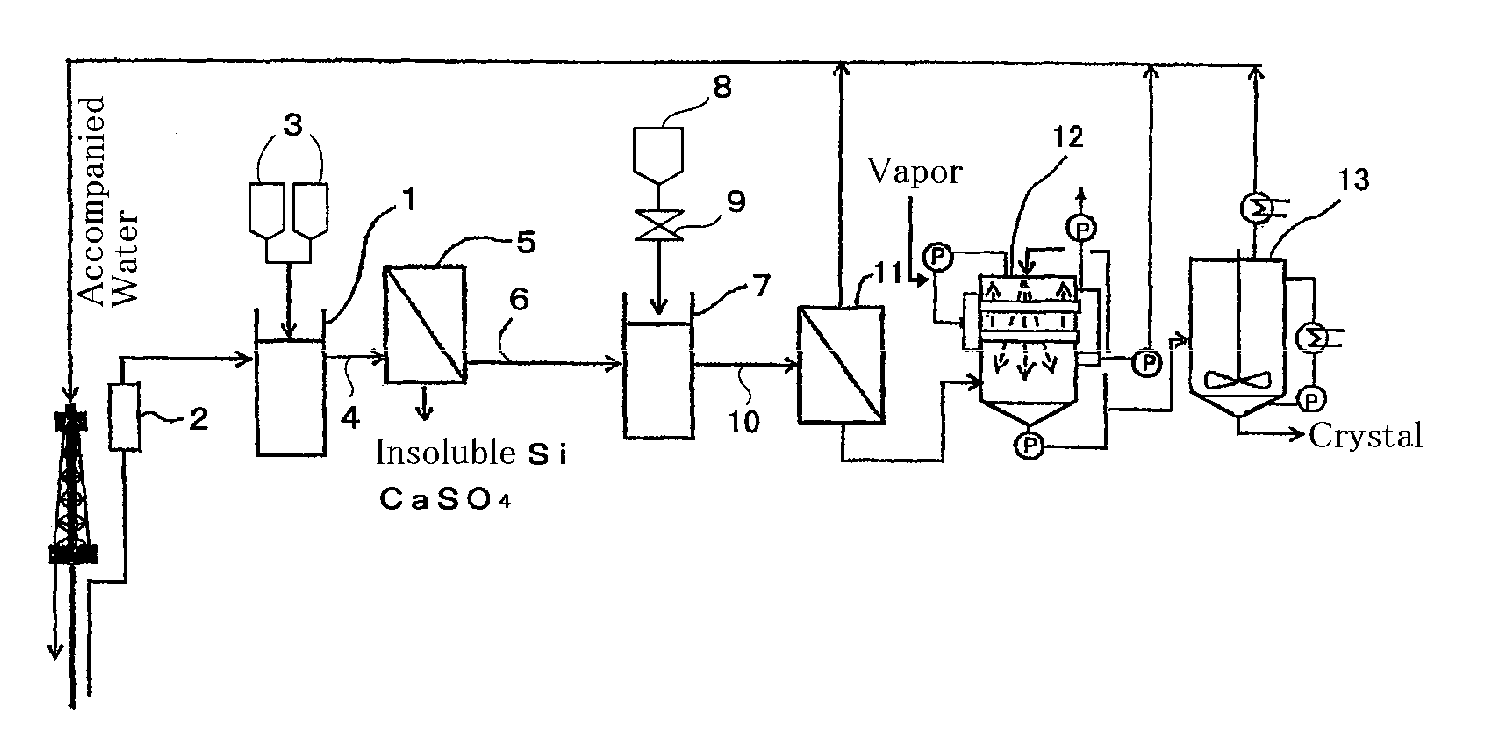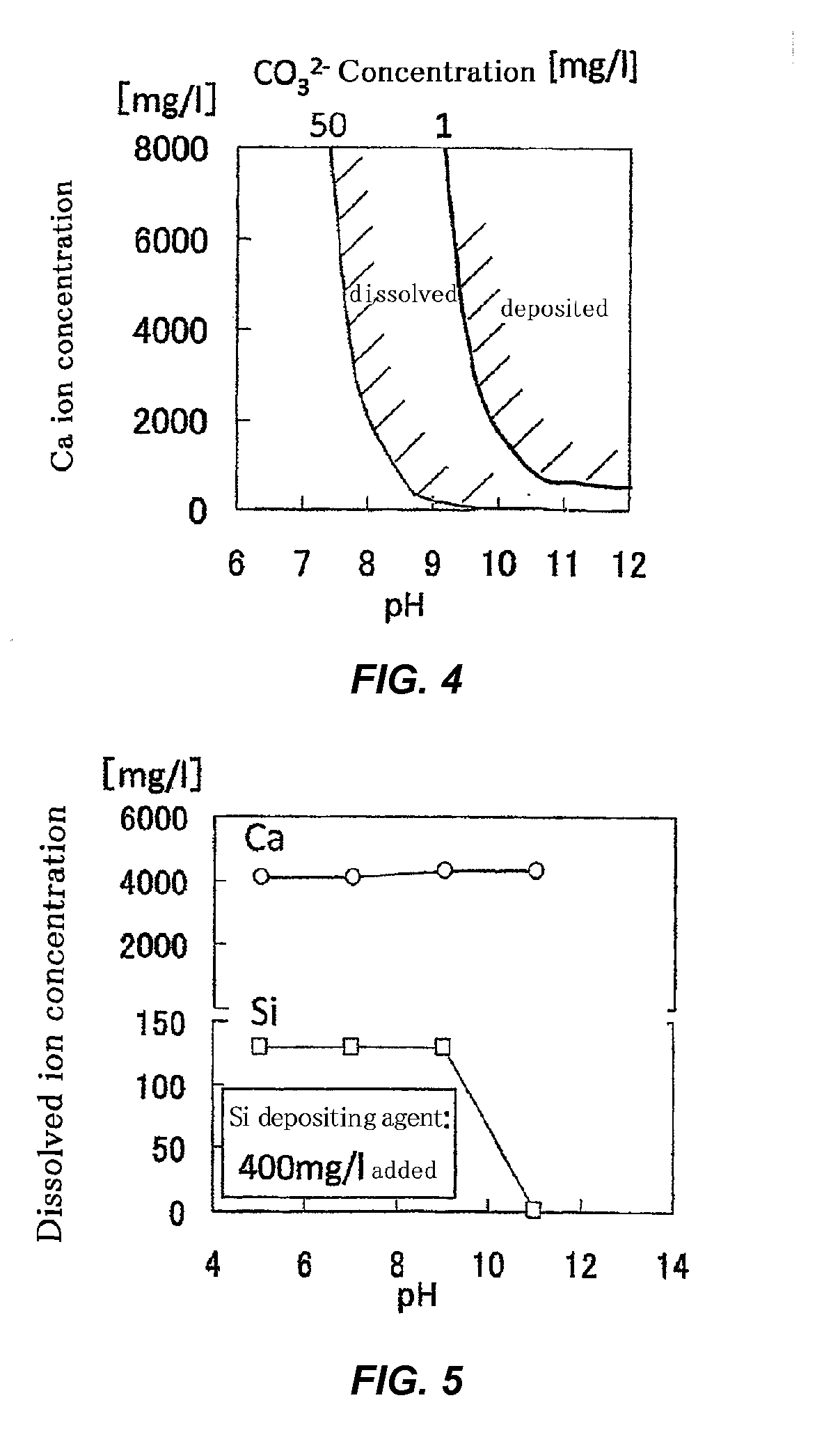Method and Apparatus for Treating Accompanied Water from A Well
a technology of accompanied water and well, which is applied in the direction of multi-stage water/sewage treatment, waste water treatment from quaries, membranes, etc., can solve the problems of environmental pollution and its removal, and achieve the effects of preventing or inhibiting the deposition of calcium carbonate, facilitating the production of accompanied water, and facilitating the treatmen
- Summary
- Abstract
- Description
- Claims
- Application Information
AI Technical Summary
Benefits of technology
Problems solved by technology
Method used
Image
Examples
example 1
[0106]100 L of an accompanied water produced from a well containing 5,000 mg / L calcium ion, 120 mg / L soluble silica, and 300 mg / L sulfate ion was adjusted to pH 10.5 by adding 5 N aqueous caustic soda solution, and aqueous magnesium chloride solution (added amount of Mg:10 g) was added thereto. It was stirred slowly at room temperature for 30 minutes to deposit insoluble silica and calcium sulfate. The first reaction solution thus obtained was filtered by a MF membrane having a pore size of 0.1 μm to obtain 90 L of filtrate of pH 10.4 containing 4,900 mg / L calcium ion.
[0107]The pH of the filtrate was made 6.5 by adding 1 N hydrochloric acid. The Langeliar saturation index of this solution was −0.6. When the pH was made 7.5 by adding hydrochloric acid, the Langeliar saturation index of the solution was +0.5.
[0108]The second reaction solution having a Langeliar saturation index of −0.6 thus obtained was treated with a RO membrane to obtain 45 L of fresh water and 45 L of RO membrane c...
example 2
[0110]To 100 L of an accompanied water produced from a well containing 5,000 mg / L calcium ion, 120 mg / L soluble silica, and 400 mg / L water-soluble organic material, 62.5 g of magnesium chloride 6 hydrates (Mg:7.5 g) and 26 g of 10% poly(aluminum chloride) solution (Al:1.4 g) ware added. The added amount was at a ratio of 1 by the molar ratio of (Mg+Al) / SiO2 and at a ratio of 3 by the molar ratio of Mg / Al. Then, the pH was adjusted to 10.5 by adding 5 N aqueous caustic soda solution, and stirred slowly at room temperature for 30 minutes to deposit insoluble silica to obtain a first reaction solution. Subsequently, to this first reaction solution, 100 mL of 1 g / L weakly anionic flocculant solution, which is a polymer flocculant, was added, and deposits were flocculated by allowing it to stand at room temperature for 1 hour. The first reaction solution treated with flocculation was subjected to solid-liquid separation by a centrifuge to separate the deposits to obtain 90 L of separated...
PUM
| Property | Measurement | Unit |
|---|---|---|
| pH | aaaaa | aaaaa |
| pH | aaaaa | aaaaa |
| pH | aaaaa | aaaaa |
Abstract
Description
Claims
Application Information
 Login to View More
Login to View More - R&D
- Intellectual Property
- Life Sciences
- Materials
- Tech Scout
- Unparalleled Data Quality
- Higher Quality Content
- 60% Fewer Hallucinations
Browse by: Latest US Patents, China's latest patents, Technical Efficacy Thesaurus, Application Domain, Technology Topic, Popular Technical Reports.
© 2025 PatSnap. All rights reserved.Legal|Privacy policy|Modern Slavery Act Transparency Statement|Sitemap|About US| Contact US: help@patsnap.com



